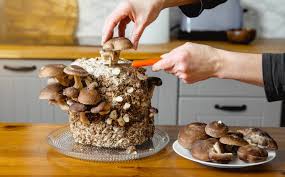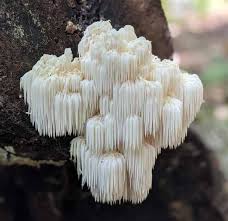
Growing mushrooms indoors
The Truth About Growing Mushrooms Indoors: What Social Media Doesn’t Tell You
Have you seen those viral videos of mushrooms sprouting from the pages of old books? While they make for captivating content, there’s a lot more to successful indoor mushroom cultivation than these social media trends suggest. Let’s dive into the real story of growing mushrooms at home – and why you might want to think twice before sacrificing your favorite paperback to the fungal gods.
The Book Method: Why It’s Not Your Best Bet
First, let’s address the elephant in the room: those mesmerizing videos of oyster mushrooms emerging from between book pages. While it might look like a magical science experiment, growing mushrooms in books poses several serious challenges. Books are far from sterile environments – they’re often homes to various molds, bacteria, and other microorganisms that could compete with your mushroom spawn. More concerning is the presence of potentially toxic inks, adhesives, and paper treatments that could affect both the growth of your mushrooms and their safety for consumption. Sure, mushrooms might grow, but is that really what you want to eat?
The Right Way to Start Your Mushroom Journey
Instead of risking your health with questionable substrates, let’s talk about proper indoor cultivation. The good news? Growing mushrooms can be just as exciting as those viral videos suggest, and when done correctly, it’s incredibly rewarding. You don’t need a science degree or expensive equipment – just the right knowledge and a few basic supplies.
Your mushroom-growing adventure begins with choosing the right variety. Oyster mushrooms are the rock stars of the beginner mushroom world – they’re resilient, fast-growing, and surprisingly forgiving of rookie mistakes. Plus, they’ll fruit abundantly when happy, giving you that Instagram-worthy harvest you’re dreaming of.
Setting Up Your Mushroom Growing for Success
The key to mushroom cultivation is creating the right environment. Think of yourself as a mushroom real estate agent – your job is to find them the perfect home. In this case, that means a clean, properly prepared substrate (growing medium), consistent temperature, and appropriate humidity. While books might seem like a quirky shortcut, materials like pasteurized straw or sterilized sawdust blocks provide a much more reliable foundation for your fungal friends.
Temperature plays a crucial role in your success story. Most popular varieties thrive in conditions between 65-75°F (18-24°C) during their growth phase. Think of it as giving your mushrooms their preferred “weather” – not too hot, not too cold, just right. Humidity should hover between 85-95%, creating that misty morning feeling that mushrooms love.
From Spawn to Harvest: The Growing Process of Mushrooms

Growing mushrooms indoors
The magic begins when you introduce spawn to your prepared substrate. This is essentially planting your mushroom “seeds,” and it’s where attention to cleanliness becomes crucial. While viral videos might skip over this detail, maintaining sterile conditions during this phase can make or break your growing success.
Over the next few weeks, watch as white, thread-like mycelium colonizes your substrate. It’s like watching a tiny fungal city expand across your growing medium. Once fully colonized, your mushroom block will be ready to fruit. This is when the real show begins – perfect clusters of mushrooms emerging over the course of just a few days.
The Art of Perfect Timing in Growing Mushrooms
Let’s talk about something that keeps even seasoned mushroom growers up at night – timing that perfect harvest. You’ve done everything right: your substrate is pristine, your temperatures are perfect, and your mushrooms are growing beautifully. But then comes the eternal question: when exactly should you harvest them? It’s like trying to pick the perfect avocado at the grocery store, except your window of opportunity is measured in days, not gentle squeezes.
Here’s the thing about mushroom growing that nobody warns you about: the temptation to wait “just one more day” is almost irresistible. We’ve all been there, watching our mushrooms grow bigger and bigger, convinced that tomorrow they’ll be even more impressive. But here’s the secret that took me years to learn – waiting for that extra growth often means missing the peak harvest window entirely. Before you know it, your beautiful oyster mushrooms are dropping spores everywhere like a mushroom snowstorm, coating everything in a fine dust that’s about as welcome as glitter at a keyboard factory.
The real magic happens when you learn to read your mushrooms like a book. Those subtle changes in cap shape, the slight slowing of growth, the way the edges begin to flatten out – these are your mushrooms practically sending you a text message saying, “Hey! We’re ready now!” Missing these signals doesn’t just mean tougher mushrooms; it can trigger a chain reaction of challenges. Spores dropping everywhere can kick off unexpected growth in corners of your growing space where you definitely don’t want mushrooms popping up. And let’s not forget how those floating spores can turn your growing room into a sneeze factory.
Think of harvesting like catching a wave – timing is everything. Too early, and you’re missing out on size and flavor development. Too late, and you’re left with tough, spore-covered mushrooms that are past their prime. The sweet spot lies in that magical moment when growth slows but before the spores start their aerial dance. For most varieties, this window appears just as the caps reach full color but before they flatten completely. It’s a bit like making perfect toast – golden brown, but not burnt.
And here’s a pro tip that took me way too long to learn: when you spot the first signs of readiness in your mushroom cluster, don’t play favorites. Harvest the entire cluster at once. Those smaller mushrooms aren’t going to catch up to their bigger siblings – they’ll just get stressed and start dropping spores along with the mature ones. It’s all or nothing in the mushroom harvest game.

growing mushrooms indoors
Remember, growing mushrooms is part science, part art, and part intuition. The more you grow, the better you’ll get at spotting that perfect moment. And if you miss it sometimes? Well, that’s just part of the learning process. After all, even the most experienced growers occasionally find themselves wiping spore dust off their growing room shelves, muttering about “just one more day” syndrome.
Sustainable Growing of Mushrooms for a Better Future
One of the most beautiful aspects of mushroom cultivation is its sustainability. Unlike many forms of food production, mushroom growing can actually help reduce waste by using agricultural byproducts as substrate. Those coffee grounds you were about to throw away? They could become the foundation for your next oyster mushroom harvest.
Beyond the Basics of Growing Mushrooms

Growing lions mane mushrooms indoors
As you gain confidence in your growing skills, you’ll discover there’s an entire world of mushroom varieties to explore. From the delicate pink oyster to the medicinal lion’s mane, each species offers its own growing challenges and rewards. Join local mycology groups, experiment with different techniques, and become part of the fascinating community of mushroom growers who are helping to revolutionize small-scale food production.
While growing mushrooms in books might make for viral social media content, successful cultivation requires a more thoughtful approach. By understanding the basic principles of mushroom growing and using proper techniques, you can create a sustainable source of nutritious food while developing a deeper appreciation for the fascinating world of fungi.
Remember, the most satisfying harvests come from doing things the right way – even if it doesn’t make for the most dramatic TikTok video. Your patience and attention to detail will be rewarded with beautiful, healthy mushrooms that you can proudly share with friends and family.


